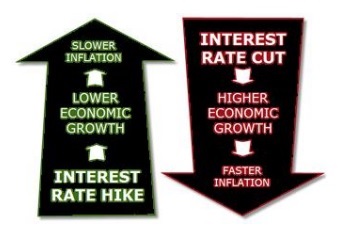
- Forex Trading - Home
- Forex Trading - Introduction
- The structure of the forex market
- Major Currencies & Trade Systems
- Types of Market Analysis
- Kinds of Foreign Exchange Market
- Benefits of Trading Forex
- Driving Forces behind Forex Market
- Fundamental Market Forces
- Technical Indicators
- Pattern Study of Trends, Support and Resistance
- Technical Strategy in Price Patterns
- Oscillator Divergences
- The Role of Inflation
- The Commodity Connection
- Position Sizing & Money Management
- Foreign Exchange Risks
- Trading Rules to Live By
Forex Trading - The Role of Inflation
Inflation gives very good indication of the current account balance of a country. Inflation measures the rate of change in prices of goods and services over a given period. An increase in inflation indicates prices are quickly rising and if the rate of inflation decreases, the prices of goods and services are increasing at a slower rate.
The rise and fall of inflation within a country also provides information about the medium term direction in foreign exchange and the current account balance of a country is also used to determine the long term movements of foreign exchange.
Higher and Lower Inflation
It is a general belief (among economic theories) that low inflation is good for the economic growth of a country while high inflation points to poor economic growth. High inflation in a country means the cost of consumer goods is high; this points to less foreign customers (less foreign currency) and the countrys trade balance is disturbed. Lesser demand of the currency will ultimately lead to a fall in currency value.
Foreign exchange is very much affected by inflation which directly affects your trades. Declining exchange rate decreases your purchasing power. This in turn will influence the interest rates.
Following diagrams show the relation between inflation, interest rates and the economic growth of a country −

A detailed knowledge on inflation helps you to make your forex market trades profitable.
Let us now see the major indicators of inflation that the market tends to watch at all times especially in forex market trades.
Gross National Product (GNP)
It is the output of the citizens of the country (like India or US) and the income from assets owned by the country entities, regardless of the location; whereas, the Gross Domestic Product (GDP) represents the total monetary value of all goods and services produced ver a specific time period the size of the economy.
GDP is usually expressed in comparison to previous year or previous quarter (3 month). For example, if the year-to-year GDP is 4%, this means the economy has grown by 4% over the last year.
GNP defines its scope according to ownership (irrespective of location); whereas, GDP defines its scope according to location.
In 1991, the US switched from using GNP to using GDP as its primary measure of production.
GDP has a direct impact on nearly every individual of the country. A higher GDP indicates there is low unemployment rate, higher wages as businesses demands labor to meet the growing economy.
How GDP affects Forex market?
Every economic data release is essential for a forex trader; the GDP data holds a lot of importance as it directly indicates the overall state of a country. As GDP data may create lots of volatility in the currency market, traders try to create a new position or may hedge their existing position (long or short position).
If the country economy is growing (GDP), the benefit will eventually affect the consumer; this leads to an increase in spending and expansion. Higher spending leads to increase in prices of consumer goods which country central bank will try to tame if they begin to outpace the rate of economic growth (high inflation).
Producer Price Index
The producer price index or PPI in short, is a monthly report detailing the purchasing price of various consumer goods. It measures the change in prices charged by wholesalers to their clients like the retailers who then add their own profit margin to the producers price and sell it to consumer.
It is important because traders mainly use the PPI as an indicator of price inflation over time. One major drawback especially for forex market traders is that PPI excludes all data on imported goods, making it difficult for traders or investor to detect the influence of one countrys market on another with respect to currency prices.
In general, the PPI is more volatile with larger fluctuations than the CPI (Consumer Price Index), is giving a macro sense of the underlying price developments that are not necessarily reflected on consumers bills.
Consumer Price Index (CPI)
The Consumer Price Index (CPI) proves effective on central banks (like RBI, US Federal Reserve), and market participants. It holds more significance when compared with the PPI.
CPI indicates the cost of living in a country, has a direct effect on interest rates.
It CPI index measures the prices changes at the retail level. It stores the price fluctuations only to extent that a retailer is able to pass them on to the consumer.
Higher CPI gives central banks (RBI, FED) the necessary supportive data to rate hikes (though its not the only factor which central bank looks for). Higher interest rates are bullish for the countrys currency.
The CPI includes sales taxes number but excludes income taxes, prices of investments like bonds or prices of homes.
The CPI report is generated monthly and covers data of the preceding month.
The core CPI is the most noticeable figures among market participants. This does not include food and energy prices and central bank (to adjust its monetary policy